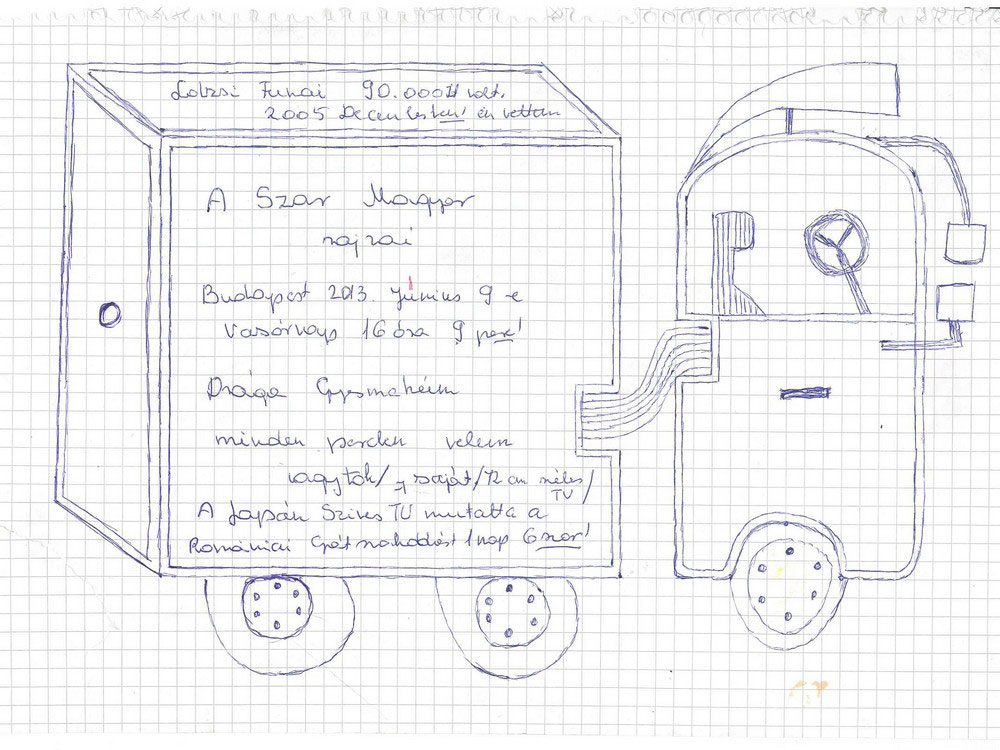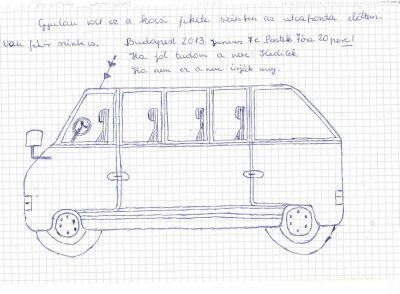László Beke, art historian
The Homeless and Art
At this point already we can get to art, that is to artists, because at that time – in the 1960’s and 1970’s – only persons who graduated from an art college were considered official/professional artists (amateurs were thus not) because only they were allowed to join the Fund (the Art Fund of the People’s Republic of Hungary). This was entered in their personal identification card as a workplace.
Who are the homeless? They are persons without a shelter or, more officially: individuals who lack permanent housing or even temporary shelter. People who habitually live in the street (or on the edge of town at least). In earlier times – at the time of the political change – we used to call them hobos. Hobos more or less referred to people who lived in underpasses. Before the political change such a lifestyle was prohibited and persons living like that were considered workshy (= unemployed), i.e. transgressors who could be caught by the police any time.
There have repeatedly emerged various types of unemployment and various responses to these, including occasional work and, more recently, public work. In sociology, the concept of deep poverty has appeared, with related phenomena like hunger, diseases, alcoholism and drugs dependence. As regards the types of housing here, the scale ranges from emergency housing to rent-a-bed, workers’ hostels and homeless hostels.
Amateurs could also be considered artists and even organized artists (the members of some amateur artists’ association or circle) but that was not considered a workplace.
Returning to the sociological problem of homelessness, the concept further comprises specifically vagabonds, wanderers, beggars, have-nots, scavengers and other forms of street living. Extreme groups involving criminal problems are thieves. Each country has its own groups of a similar character but specific nature, e.g. clochards in France who sleep under the bridges of the Seine.
Homelessness is primarily a sociological (societal) problem and experts of the field comprise specialized social workers. The problem also has health care – medical, hygienic, epidemiologic – criminalistic, psychological, cultural relevance as well as relevance for the quality of life, etc. It is obvious that the homelessness problem must be addressed. But how does art come in the picture?
As far as I know Emőke Visnyei has been the first in the history of Hungarian homelessness to be involved with her clients consciously, with high commitment and empathy, from the aspect of art therapy. There had, however, been similar attempts before:
At the time of the political change, Miklós Erhardt and the Scotsman Dominic Hislop gave some homeless persons cameras and their photographs taken of one another were presented at an exhibition (Big Hope, 1996/98–2005). For some time, Simon László Csorba led an art therapy group for homeless persons. László Fehér photographed homeless persons at Moszkva square (with their written consent and for suitable payment), after which he made hyperrealistic paintings of them (currently in the collection of Ludwig Museum of Contemporary Art). I myself had a plan at the end of last century to organize an exhibition of homelessness at the Kunsthalle of Budapest: I was “simply” to invite homeless persons to live in the exhibition halls for a few weeks. This plan was not implemented. Later on Róza El Hassan exhibited beggars’ handwritten boards at the same place. (Visitors could see similar experiments abroad at that time: a client’s bicycle at the Museum of Modern Art in Frankfurt.)
Over four years ago (in April 2014) Visnyei started organizing exhibitions (initially together with the staff of Tárt Kapu (Open Gates) Art Gallery) for homeless persons she worked with as a social worker and art therapist. She was the first person who made (me) aware (also) of the fact that the inhabitants of a homeless hostel were often ill at the same time, in the physical or psychological sense. She started to encourage them to draw and paint, and provide an explanation for their works or even write a poem to accompany them. Later on she made them paint the walls and doors of hostels.
Art therapy for the homeless interconnects or even overlaps with other professional efforts such as the Budapest centres of today’s “art brut” and “outsider art”: Budapest Art Brut Gallery of Moravcsik Foundation and Átkelő (Transit, earlier Tárt Kapu) Gallery. Here, too, the issue of various “artistic” trends and styles prevails. According to the paradigm shift that took place in the 2nd half of the 1960’s and especially around 1968, everything (and anything) can be considered art and everyone (and anyone) can be considered an artist, thus including homeless art as well. This was at the same time the period of “high and low” art, where the homeless and outsiders belonged to the latter category. It was one among similar kinds: children’s drawings, dilettante art, the art of the mentally ill, naïve art, Romani art, primitive art, prison art and nuns’ art, in addition to marginal branches of art. If one considers art as a value criterion, the quality of certain artworks can be debated, but what cannot be disputed is the expressivity of homeless art as a whole. Expressivity may have several other possible forms of appearance ranging even to awful or obsessive.
As another aspect of “high and low”, poverty has been a popular topic for “high” art since at least the 19th century, especially for literary fiction, socio- and documentary photography, film-making (Balázs Béla Studio), theatre…
It is not only fine arts that you can speak of here but all the other branches of art as well, including especially (street) musicians and singers, showmen, dancers, more recently rappers and poets who in older times sold their poems at cafés. Specific genres in fine arts are graffiti and pavement art; a genre popular with young people as a source of earning money is fast drawing (fast street portraits or caricatures). In the papers sold by the homeless, e.g. Fedél Nélkül (Without a Shelter) poems and prose are common in addition to drawings and caricatures.
As follows from the above, therapy for the homeless, too, can be performed in any genre or medium. From those that have not been mentioned, role play, the wide range of industrial arts and handicrafts, decorative arts, wood carving, “folk” art are of special interest. By applying technical media – photo, film, video – persons with disabilities or handicaps of various kinds (autism or Down syndrome) have produced awesome results.
Many therapists presume that art therapies cannot but succeed in general, as manual activity triggers good feelings in the creating person. Emőke Visnyei thinks the same way because she wants to help; she boosts creators’ self-confidence by taking them to exhibitions. Recently she has experimented with icon painting, thereby getting in touch with sacred art and Sacrality itself. In the meantime her professional expertise has expanded as well: from her college studies (in 2005 she wrote a thesis with the title The Johanniter Order and Charity Service) she progressed to writing a university thesis in the major of Social Work (2018: Meaning-centred social work: combining logotherapy and art therapy in social work), attaining the position of university lecturer and presumably further in the field of scholarliness…
Although in the new situation arising out of the new homelessness act many things can happen, participants can only win from applying art therapy. This may seem to be a commonplace, but its truth content can probably be confirmed with a similar consideration: there are no two homeless persons who are the same and every personality has different positive characteristics to unfold.
Budapest, 30 December, 2018
László Beke





